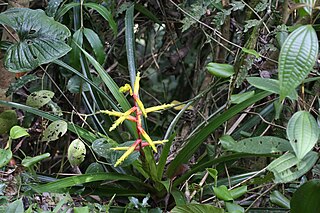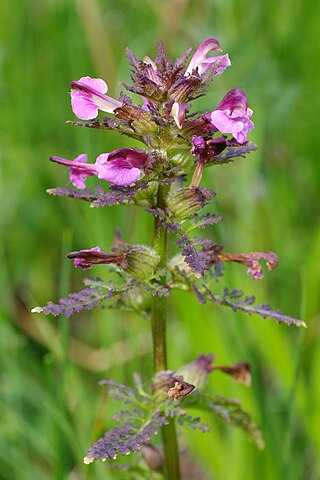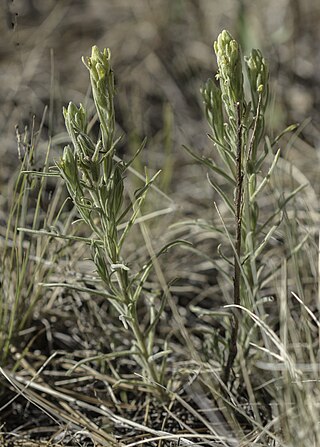
El Cajas National Park or Cajas National Park is a national park in the highlands of Ecuador. It is located about 30 km west from Cuenca, the capital of the province of Azuay. The area of 285.44 km2 between 3100m and 4450m above sea level is characterized by páramo vegetation on a jagged landscape of hills and valleys. It was declared a National Park on November 5, 1996 by resolution N° 057.

Guzmania xanthobractea is a species of plant in the family Bromeliaceae. It is endemic to Ecuador. Its natural habitats are subtropical or tropical moist lowland forests and subtropical or tropical moist montane forests. It is threatened by habitat loss.

Castilleja minor is a species of flowering plant in the family Orobanchaceae known as thread-torch paintbrush or seep paintbrush. It is native to western North America from British Columbia to California and eastward to the Rocky Mountain states.

Veronica anagallis-aquatica is a species of flowering plant in the family Plantaginaceae known by the common names water speedwell, blue water-speedwell,brook pimpernel.

Castilleja septentrionalis is a species of Indian paintbrush known by several common names, including northern paintbrush, sulfur paintbrush, and pale painted cup. There is taxonomic disagreement as to if it is one species widely distributed in mountain and alpine environments of North America or if there is a second species, Castilleja sulphurea, in the Rocky Mountains.

Castilleja kaibabensis is a species of flowering plant in the family Orobanchaceae known by the common name Kaibab Plateau Indian paintbrush. It is endemic to the Kaibab Plateau of Coconino County, Arizona, in the United States.
Castilleja salsuginosa is a species of flowering plant in the family Orobanchaceae known by the common name Monte Neva Indian paintbrush. It is endemic to Nevada in the United States, where it is known from two populations, one in White Pine County and another in Eureka County. The two occurrences of this plant are located about 83 miles (134 km) apart within the Great Basin. There are only about 275 individuals.

Castilleja integra, with the common names orange paintbrush, Southwestern paintbrush, and wholeleaf paintbrush, is a partially parasitic herbaceous perennial plant native to the Southwestern United States and Northern Mexico. The species produces a relatively large amount of nectar and is attractive to hummingbirds. It is better suited to cultivation than most other species in the paintbrush genus (Castilleja) and is therefore used in xeriscape gardens and naturalistic meadows, even outside its native range.
Castilleja kerryana is a species of flowering plant in the family Orobanchaceae. It is commonly known as Kerry's Indian paintbrush or Kerry’spaintbrush. It was formally described in 2013 and so far it is known only from a small population in the state of Montana, in the Northwestern United States.

Castilleja chromosa, the desert paintbrush, is a species of flowering plant in the family Orobanchaceae found in the western United States. They are distributed in dry scrub, steppe, and desert. They have colorful inflorescences which range from yellow to red in hue. This color is given not by the flowers, which are small, but by the colorful bracts. The plants grow up to nearly half a meter tall and are slightly bristly and greyish-green. Their stems do not branch, and their leaves are small and lance-shaped. Partial parasites, they steal some of their nutrients from neighboring plants.

Cycnium tubulosum, also known as the vlei ink-flower and the tissue paper flower, is a slender hemiparasitic perennial plant of the broomrape family. Its range includes much of southern and eastern Africa, from South Africa to Ethiopia, including Madagascar. It has creeping, straggling or upright stems, with few narrow, entire leaves and erect, white or pinkish, slightly zygomorph flowers on a long tube, with five lobes, reminiscent of a Phlox-flower. It may not always be fully dependent on the supply of minerals by other plants, but usually makes connections with the roots of grasses. It can be found in moist, short grasslands, reaching altitudes of about 1,550 m (5,090 ft). Its conservation status in South-Africa is "least concern".

Mimetes stokoei, the mace pagoda, is an evergreen, upright, hardly branching, large shrub of 1–2 m high in the family Proteaceae. It has silvery, oval leaves of 5–8 cm (2.0–3.2 in) long and 2+1⁄2–4 cm (1.0–1.6 in) wide, with one large tooth supported by two smaller teeth near the tip, at an upward angle and somewhat overlapping each other. The inflorescences are set just below the growing tip, are cylinder-shaped, 10–12 cm (4–5 in) high, topped by a crest of small, more or less horizontal, pinkish-purple tinged leaves. It consists of several flower heads in the axils of golden leaves with a pinkish wash that form a hood shielding the underlying flower head. Each flower head contains eight to twelve individual flowers, with amber-colored styles topped by blackish purple pollen presenters and grey silky perianth lobes. It is endemic to the Fynbos ecoregion of South Africa, being confined to the Kogelberg mountain range. The mace pagoda was twice presumed extinct, but reappeared in its natural habitat from seed, after a wildfire several decades later.

Pedicularis palustris, commonly known as marsh lousewort or red rattle, is a plant species in the family Orobanchaceae. It is native to central and northern Europe and Asia where it grows in wetlands and boggy habitats. The International Union for Conservation of Nature has assessed its conservation status as being of least concern.

Castilleja elmeri is a species of flowering plant in the family Orobanchaceae with the common name Elmer's paintbrush. As with most Castilleja species, this is a facultative root hemiparasite and will usually be seen growing close to a host plant.

Castilleja kraliana, is a species of flowering plant in the family Orobanchaceae known by the common names Cahaba paintbrush or Cahaba Indian paintbrush.

Castilleja thompsonii is a species of hemiparasitic perennial herb in the Orobanchaceae family with the common name Thompson's Indian paintbrush. It is native to south central British Columbia and Washington State.

Castilleja rhexiifolia, commonly called rosy paintbrush, subalpine paintbrush, or rhexia-leaved paintbrush, is a species of plant in Orobanchaceae, commonly known as the broomrape family. They are a common flower found in moist habitats near or above timberline in the Rocky Mountains and the Pacific Northwest. Like most members of the Castilleja genus, they are partially parasitic plants.

Castilleja lineata, commonly known as marshmeadow paintbrush or linearlobe paintbrush, is an uncommon species that largely grows in the mountains of northern New Mexico, but is also found in small areas of neighboring Colorado and Arizona. It was not scientifically described until 1901 and is little studied.

Ourisia muscosa is a species of flowering plant in the family Plantaginaceae that is endemic to páramo habitats in the Tropical Andes mountains of Colombia, Ecuador, Peru, Bolivia and Chile. George Bentham described O. muscosa in 1846. Plants of this species of South American foxglove are small, perennial, and repent herbs with entire and tightly clustered, sometimes opposite, leaves. The flowers are solitary, with a regular calyx, and a regular corolla, and with two floral bracts that cover the calyx. The calyx has tiny glandular hairs, whereas the corolla is glabrous and white on the outside, and yellow and hairy inside.

Castilleja scabrida, commonly known as rough paintbrush or Eastwood paintbrush, is a species of plant in Castilleja, the paintbrush genus from the Intermountain West mainly in the states of Nevada, Utah, and Colorado.


















